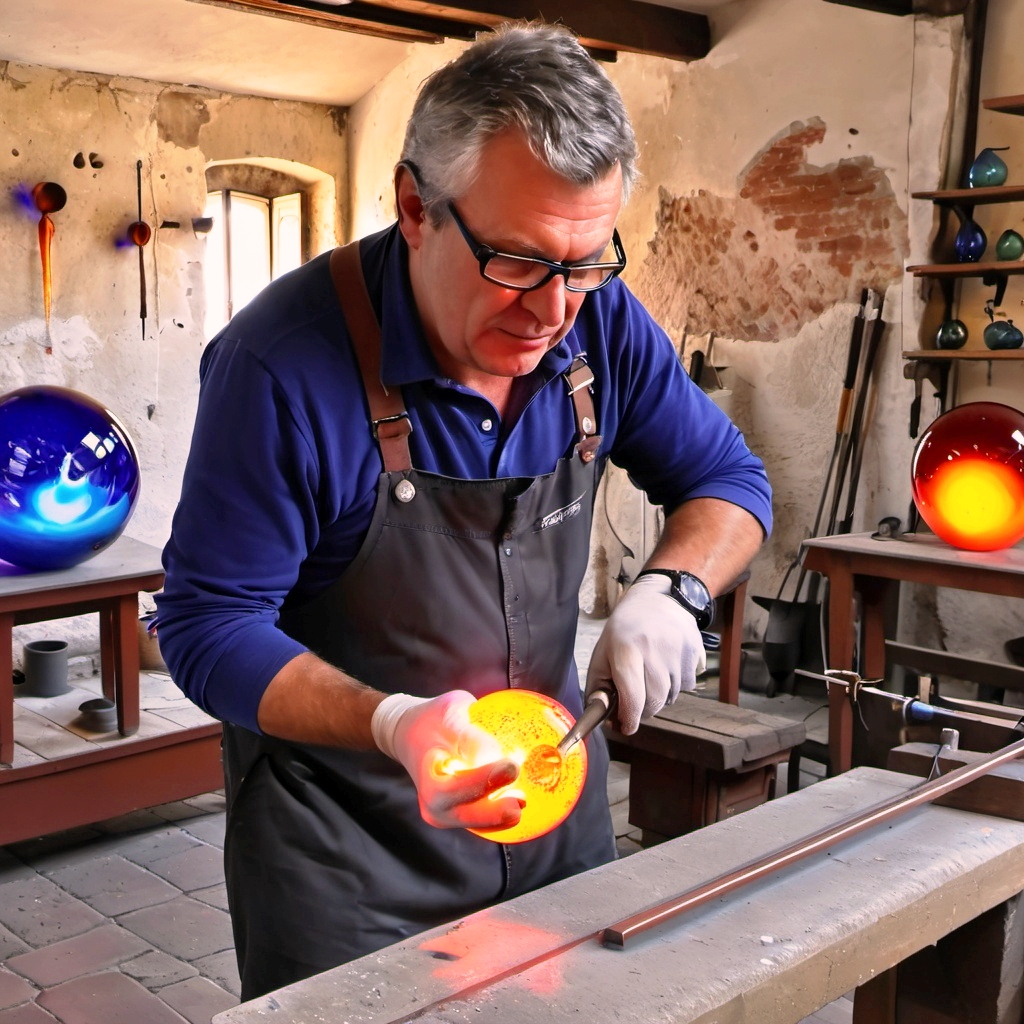
Murano glass, a name linked with exquisite workmanship and artistic brilliance, has fascinated the globe for centuries.
This one-of-a-kind glassware, made on the Venetian island of Murano, is more than simply a commodity; it is a tribute to a rich cultural legacy, a fusion of tradition and innovation, and a reflection of its producers’ artistic soul.
This page dives into the history of Murano glass, the tools and techniques used to make it, the cultural traditions that surround it, and the various ornamental styles and designs that have evolved throughout time.
Historical Development Of Murano glass
Origins: Venice
Murano glass dates back to the eighth century, when glassmaking first began in Venice. However, in 1291, the Venetian authorities ordered that all glass furnaces be relocated to the island of Murano.
This decision was largely prompted by safety concerns, as the glassmaking process required high temperatures and presented a fire risk to Venice’s wooden structures.
By transferring the furnaces, the government hoped to preserve the city while simultaneously establishing a vibrant glass sector on Murano.
The Golden Age
The 15th and 16th centuries were the golden ages of Murano glass. During this time, the island became a hotspot for talented artisans who pioneered new methods and styles.
Murano glassmakers were well-known for their hidden procedures, which were frequently passed down through generations.
This exclusivity enhanced the grandeur of Murano glass, making it greatly sought after by aristocracy and affluent merchants throughout Europe.
Renaissance Influence
The Renaissance reignited interest in art and culture, and Murano glassmakers were at the forefront of this trend.
They started experimenting with new shapes and colors, combining elaborate patterns and motifs inspired by nature, mythology, and religious themes.
The use of gold leaf and brilliant colors became popular, resulting in magnificent items that were both useful and ornamental.
The Decline and Revival
The Murano glass industry declined during the 17th and 18th centuries as a result of rivalry from other European glassmakers, mainly in Bohemia and England.
However, the nineteenth century saw a renewed interest in classic glassmaking processes. Artisans began to re-embrace their tradition, resulting in a rebirth in the creation of premium Murano glass.
Today, the island remains a hub for glassmaking, with craftsmen combining old techniques with modern creations.

Traditional tools of Murano glass
Murano glass is created with a range of specialized instruments that have been used for generations. Some of the most crucial instruments are:
-Blowing irons are long, hollow metal tubes used to mold molten glass. The talent of the glassblower is critical in defining the final shape of the object.
-Marver is a flat stone or metal surface where glass is rolled into form and cooled before further manipulation. This tool aids in achieving a smooth surface and consistent thickness.
-Puntello is a tiny instrument used to support and handle glass during the blowing process. It enables craftspeople to make complicated forms and decorations.
-Shears are scissors-like equipment used to cut and shape glass. They are useful for reducing surplus glass and producing intricate embellishments.
-Molds are used to generate certain shapes and patterns and can be constructed of metal or wood. They ensure stability in manufacturing while allowing artists to experiment with various patterns.
Techniques
Murano glass artisans use a range of techniques to produce their masterpieces. Some of the more noteworthy approaches are:
Glassblowing is a well-known technique that includes expanding molten glass into bubbles and molding them into different shapes.
This technology enables for the construction of both useful and artistic sculptures.
-Millefiori, meaning “a thousand flowers” in Italian, is a technique of fusing colored glass canes to form beautiful designs. The canes are split to expose stunning patterns, which typically resemble floral themes.
-Filigrana is a technique that uses fine strands of colored glass to create delicate, lace-like designs. Filigrana creates depth and texture in the glass.
-Sommerso is a method that layers multiple hues of glass to create a striking visual effect. The outer layer is typically translucent, enabling the colors beneath to show through.
-Enameling involves applying colorful enamels to the surface of glass before fusing it in a kiln. This method allows for detailed patterns with brilliant colors.

Decorative Styles and Designs
Classic Styles
Murano glass is recognized for its timeless designs. Some of the most iconic designs are:
Vases: Murano vases come in a variety of forms and sizes, with exquisite designs and brilliant colors. Collectors appreciate their ability to be both utilitarian and attractive.
Chandeliers: Murano chandeliers are masterworks of craftsmanship, frequently embellished with exquisite glass flowers and elaborate detailing. These magnificent light fixtures exemplify luxury and elegance.
Figures: Artisans make fanciful and lifelike figurines that depict animals, humans, and mystical beings. These sculptures highlight the expertise and ingenuity of Murano glassmakers.
Murano Glass embraces contemporary design
Murano glass has recently developed to include modern design aspects. Modern artisans explore with abstract shapes, minimalist aesthetics, and unusual color combinations.
This blend of history and innovation has sparked renewed interest in Murano glass among younger generations and contemporary art fans.
However, Murano glass has evolved dramatically in recent years, including contemporary design features that reflect current aesthetics and sensibilities.
Modern Murano artisans are pushing the limits of traditional glassmaking by experimenting with abstract forms and new processes.
While traditional Murano glass creations frequently incorporate intricate patterns and historical elements, today’s artisans choose simplicity and abstraction.
This transition allows for a new interpretation of glass art, appealing to a younger generation of collectors and design aficionados.
a new interpretation of glass art
One of the most notable innovations in Murano glass is the use of bright colors and unusual forms. Artisans are increasingly making sculptures that test the viewer’s perspective by using asymmetry and unusual materials.
For example, glass sculptures may integrate metal or wood, producing a startling contrast that enhances the overall beauty.
This combination of materials also matches current design trends that emphasize mixed media.
Furthermore, current Murano glass artisans are being impacted by worldwide design trends.
They draw inspiration from a variety of cultures and artistic traditions, creating one-of-a-kind creations that appeal to a wide range of audiences.
This worldwide vision has resulted in the construction of glassworks that are not only useful but also serve as focal points in modern environments.
The contemporary Murano glass movement
Sustainability is another important feature of the contemporary Murano glass movement. Many craftsmen are embracing eco-friendly methods, such as recycling materials and employing energy-efficient production techniques.
This dedication to sustainability is consistent with the ideals of today’s consumers, who are increasingly looking for items that are both beautiful and ecologically friendly.
The progression of Murano glass into contemporary design demonstrates the versatility and innovation of its craftspeople.
By combining ancient processes with modern aesthetics, they ensure that this age-old skill stays relevant in today’s fast-paced world.
As we look ahead, it is apparent that Murano glass will continue to fascinate and inspire, bridging the gap between tradition and modernity.
Murano glass’ heritage, whether in the form of abstract sculptures or practical art pieces, is positioned to shine brilliantly in the world of modern design.

The vibrant color palette of Murano glass
Murano glass is known for its rich color pallet. Artisans employ a number of techniques to obtain rich hues, frequently blending multiple colors to create distinct effects.
The texture of Murano glass also varies, with some pieces having smooth surfaces and others having a more tactile, textured finish.
Murano glass, known for its beautiful craftsmanship and rich history, is a breathtaking example of Italian creativity.
This glassmaking technique originated on the Venetian island of Murano and goes back to the 13th century.
Brilliant color pallet
One of the most appealing characteristics of Murano glass is its brilliant color pallet, which has developed over ages to represent both natural beauty and the imaginative energy of its workers.
Murano glass colors are profoundly entrenched in the processes and materials used in the glassmaking process, rather than just being aesthetically pleasing.
Artisans use a variety of minerals and oxides to generate a wide range of colors. For example, cobalt oxide creates vivid blues, but copper may provide rich greens.
The addition of gold and silver leaf can create shimmering effects that improve the visual attractiveness of the glass.
This painstaking mixing of materials allows for a wide range of hues, both bright and subtle, making each piece unique.
The use of brilliant reds and yellows in Murano glass is one of its most distinctive color combinations, which can be found in classic works such as vases and chandeliers.
These warm tones inspire the Italian sun and the region’s vivid scenery. Cooler hues, such as turquoise and emerald green, represent the calm waters of the Venetian lagoon, resulting in a harmonious overall palette.
Murano glass workers are particularly well-known for their inventive techniques, such as “millefiori,” which involves fusing colored glass canes to create elaborate designs.
This approach produces gorgeous floral and geometric designs that highlight the brilliant colors in a compelling manner. The use of colors in these patterns adds depth and complexity, transforming each item into a work of art.
Modern Murano glass artisans
In recent years, modern Murano glass artisans have experimented with new hues and finishes, challenging established color palettes.
This progression has resulted in the production of works with surprising hues, such as brilliant purples and delicate pastels, that appeal to current tastes while still reflecting Murano glassmaking’s rich legacy.
Murano glass’s vivid color pallet reflects the artists’ expertise and ingenuity. Murano glass’s hues continue to enchant collectors and enthusiasts alike, thanks to their deep historical origins and modern advancements.
Each item tells a narrative, reflecting the beauty of nature and the creativity of human hands, establishing Murano glass as a everlasting treasure in the world of art and design.

Murano glass: Cultural Tradition
The Role of Family
Murano glassmaking is profoundly influenced by family traditions. Many artists descend from generations of glassmakers, and the trade is frequently passed down from parent to child.
This familial link instills a sense of pride and obligation to preserve the quality and creativity associated with Murano glass.
Guilds and Regulations
Historically, Murano glassmakers created guilds to preserve trade secrets and maintain high quality standards.
These guilds played an important role in regulating the industry, ensuring that only trained artisans could make glass.
Today, the “Consorzio Promovetro” is a regulating organization that promotes and protects the Murano glass trademark by guaranteeing that items satisfy certain quality criteria.
Festivals and Celebrations
Murano organizes a variety of festivals and events to commemorate its glassmaking tradition.
One of the most renowned is the “Festa del Redentore,” a religious celebration with a stunning fireworks show over the lagoon.
During this time, craftsmen display their work, and visitors may see live glassblowing demonstrations to get a look into the genius behind Murano glass.


